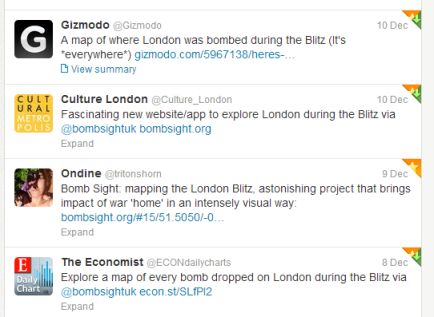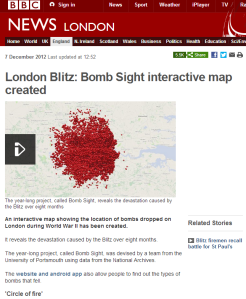When we launched the Bomb Sight website at the end of November, none of the project team had imagined quite how much interest there would be in the project.
We were pleased when we saw some people starting to tweet about it, and saw the number of visitors rise to 40 a day this time last week.
When I spotted at lunchtime on Wednesday that we were seeing an increasing level of traffic from Twitter, I sent a tongue-in-cheek email to the team saying I thought it might be starting to go viral. At that point we were seeing about one visitor a minute, and by the end of the day we were seeing about one every ten seconds, and had served 2,235 visitors over the course of the day. The web site was starting to feel a bit slow at times, but we think it was serving most visitors who tried to access the site.
A tweet from @qikipedia to their 357,000 followers suggests we were struggling by Thursday morning, but we kept serving visitors at about the same level of demand as we were on Wednesday… until 4pm on Thursday when we saw the first media article about the project.
That’s when we really realised that the server couldn’t keep up with the demand of 8,000 visitors an hour – and you would likely have been seeing errors quite often – so Patrick and I started to look at the server to see what we could do to help it scale with the resources we had available. I think we managed to squeeze a bit more capacity out of it, so some more people were able to view the site if they were lucky enough to get through. We definitely weren’t able to make it available to everyone who was trying to access the site though.
Thankfully we spotted a tweet that evening from CloudFlare, a company that specialises in delivering content faster and more reliably by sitting between the users accessing the site and the website itself. They shelter your server from intense levels of traffic by keeping a copy of your pages on their own servers and serving that out to users on your behalf.
Thursday evening was spent trying to get this set up and working, and by 1am we were seeing about 30 users a minute again. It wasn’t quite the 5 minute setup they advertise – as we waited for DNS changeovers, tried to get to grips with the configuration needed, competed with everyone else to access our own pages, and tried to keep our server online enough for CloudFlare to cache copies of the pages – but by the end of the night I was feeling a bit more comfortable that we’d be able to keep the website running a bit better for the next day. The front page of the site (the main map) was being cached by CloudFlare, and that was the most important part to keep working.
We had already served 18,459 visitors on Thursday, but that still wasn’t the busiest day we’d see. By far.
By Friday morning, Patrick noticed that CloudFlare had started serving out a 404 Not Found error message instead of the homepage, which we battled with for a while, but managed to get rid of in the end. At 11am we were serving about 40 visitors a minute, until the BBC published their article around noon and we hit 380 visitors a minute, or 6 a second. And probably quite a few error pages too, unfortunately, as we worked to get rid of the remaining ones.
Friday saw around 185,000 visitors coming to the site, which just would not have been possible if we didn’t have the support of CloudFlare to serve the vast majority of that traffic for us.
Up to this point on Tuesday, we have already had somewhere between 300,000 – 500,000 visitors* to the Bomb Sight website, and are currently serving about 900 visitors an hour. According to CloudFlare, these visitors have viewed upwards of 1.8 million pages between them.
We have shifted around 3 terabytes of data, of which CloudFlare has served about 2.7TB for us. 1.2TB of that were in the first 24 hours, and at the peak we were seeing a throughput of about 150GB an hour. That’s a lot of data, especially when it was wasn’t planned for in advance.
The moral of the story – if you think there’s even the slightest possibility your project may go viral, plan in advance to add in a service such as CloudFlare to take some of the traffic away from your servers and give you some breathing space. Especially considering it’s free to use their service!
As we posted on Thursday, we’re sorry if you’ve had troubles accessing the site so far, but we hope that you were eventually able to access the site, and will be able to explore it further now that we’re better equipped.
We are noticing from the statistics that people are starting to come back and explore the site more – with almost 25% of visitors today being people who have viewed the site more than once – which is a good sign that the data is of value and interest to people who want to learn more about the history London. We’re also starting to see more people finding the site from Google searches about the Blitz, and about particular parts of London.
* it’s difficult to accurately measure the number of visitors to the site, partly because some users will have seen error messages, others may not have been counted if they viewed the site embedded in a media article, and different services give statistics calculated in different ways. The visitor statistics in this post are all from Google Analytics while the data statistics are from CloudFlare.
 The Bomb Sight Android app is now available to download for free through the Google Play store.
The Bomb Sight Android app is now available to download for free through the Google Play store. Screenshot of the map view
Screenshot of the map view Screenshot of the location on the original bomb census
Screenshot of the location on the original bomb census Screenshot of the augmented reality view
Screenshot of the augmented reality view









